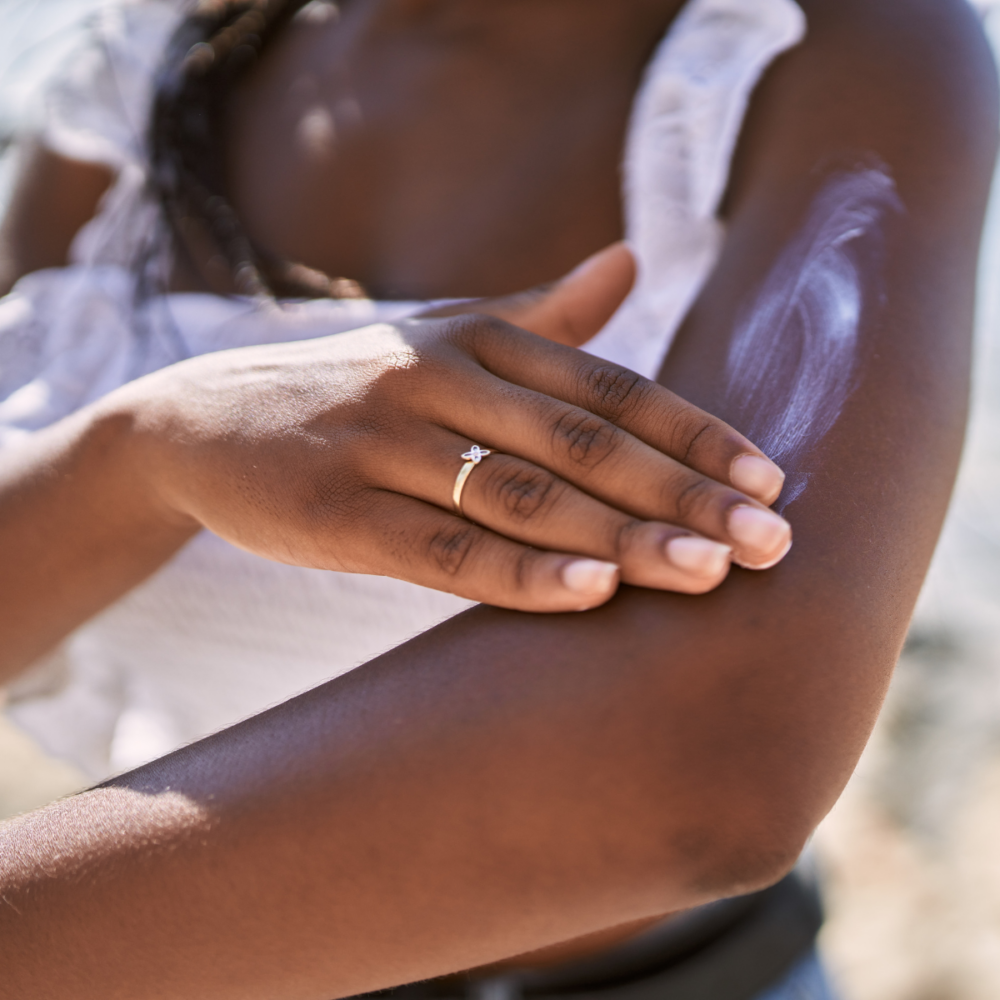त्वचा की गहराई: गहरे रंग में त्वचा कैंसर को समझना

Anyone, regardless of skin color, can get त्वचा कैंसर. It’s the one of the most common types of cancer in the U.S., with an estimated 3.3 million people diagnosed with non-melanoma skin cancers (such as basal cell or squamous cell carcinoma) annually and over 200,000 cases of invasive and non-invasive melanoma expected in 2024. While advances in skin cancer detection and treatment mean fewer people overall are dying of skin cancer, it’s more often associated with fair-skinned individuals—which means non-white people are more likely to be diagnosed at a later stage.1
Sun protection and screening
Contrary to popular belief, darker skin tones do not provide natural sun protection. Although eumelanin—the type of melanin most prominent in skin of color—does absorb some ultraviolet (UV) rays from the sun, all skin tones require sunscreen when outside, and all people are susceptible to skin cancer.
All this means it’s important for everyone to get a routine skin check every year to check for cancer—but most people are behind on their screenings, and patients with darker skin tones may be less likely to get regular full-body skin exams.2 The Prevent Cancer Foundation’s 2024 Early Detection Survey revealed that more than half of U.S. adults are not up to date on their routine skin cancer screening. Among Black or African American survey respondents, 34% reported having never had a skin cancer check. Percentages of those who have never had a skin cancer check were similar among respondents who identified as Hispanic or Latino (34%) and Indigenous Peoples (29%).
While monthly self-checks of your skin can also be important, skin cancer can be harder to identify on darker skin tones as compared to on light or fair skin tones. When those with lighter skin tones develop cancerous growths, they are often more noticeable due to the difference in color between the growth and the surrounding skin. In people with darker skin tones, growths may be less evident as the differences in color are not as pronounced. A dark spot, such as a mole, may be more difficult to see on darker skin. Additionally, skin cancer may not always appear as a mole, but rather may appear as a scaly patch of skin, a raised bump, a sore that won’t heal or a dark line around or underneath a nail. If you have darker skin, it’s a good idea to have your skin check done by a health care provider, like a dermatologist, who is experienced in identifying skin cancer on all skin tones and knows what to look for.
People with darker skin are more vulnerable to melanoma where sun exposure isn’t as common, such as the palms of the hands, the soles of the feet, around the genitals and under the nails. When you get an annual skin check, your health care provider should be checking your skin thoroughly, head to toe, to look for warning signs that may appear anywhere on the body—even where the sun doesn’t shine.
Research advances and limitations
New skin cancer screening tools are emerging, but that doesn’t mean they can be used effectively in all patients.
Veronica Rotemberg, M.D., Ph.D., a 2023 Prevent Cancer Foundation research grant recipient, knows artificial intelligence (AI) is on the horizon when it comes to detecting skin cancer.
“When we think about AI and how it affects patients of color, we know fundamentally that the training data, because it comes from a health care system that is structurally inequitable, will be biased,” she said.
That’s why she’s studying how skin tone affects AI performance for skin cancer detection.
“Research in early detection, including how to improve early detection of skin cancer and reduce potential harms of screening or biases in screening tools, will directly impact our dermatology patients and our profession,” Dr. Rotemberg said.
In addition to underdiagnosis, there’s reason to be cautious about how state of the art AI models may overdiagnose melanoma in patients of color, according to Dr. Rotemberg.
“We really are just at the beginning of understanding how biases in our training data and AI models will affect people in practice,” she said.
The Prevent Cancer Foundation is committed to advancing health equity as part of our vision of a world where cancer is preventable, detectable and beatable for all. We’re proud to support researchers like Dr. Rotemberg who are working to reduce the disproportionate impact of cancer on people of color.
How to protect yourself
Regardless of the color of your skin, here are some tips everyone should keep in their back pocket not just this summer, but year-round:
- अपनी त्वचा को जानें: Regularly examine your skin from head to toe, including areas not typically exposed to the sun. Look for any changes in moles with the ABCDE rule:
- एsymmetry
- बीorder irregularity
- सीolor that is not uniform
- डीiameter greater than 6mm
- इvolving size, shape or color
- Wear sunscreen: Even on a cloudy day, sunscreen is a must. Make sure to choose sunscreen with SPF 30 or higher with UVA and UVB protection (broad spectrum). Don’t forget to reapply every two hours.
- धूप में रहने से बचें, विशेषकर सुबह 10 बजे से शाम 4 बजे के बीच, जब सूर्य की रोशनी सबसे तेज होती है।
- Never use tanning beds or sunlamps.
- Visit the dermatologist: You should visit a dermatologist or have a health care provider examine your skin every year.
1ब्रैडफ़ोर्ड पी.टी. (2009)। रंगीन त्वचा में त्वचा कैंसर। त्वचाविज्ञान नर्सिंग, 21(4), 170–178